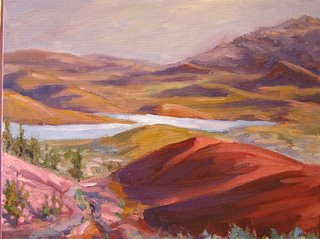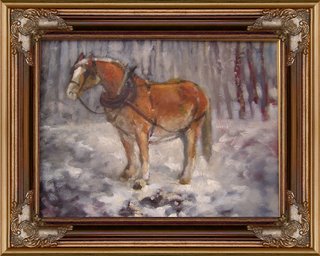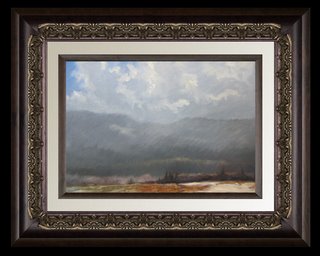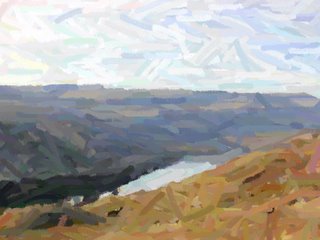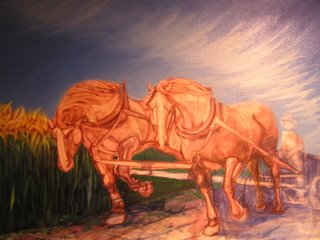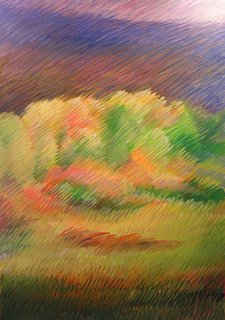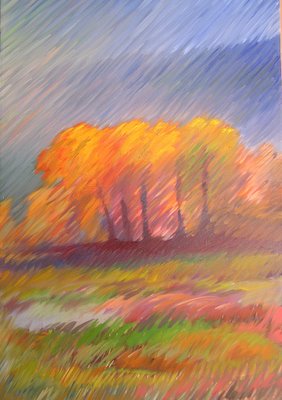Art Notes to self from DC
Friday, March 3, went on a "Gallery Walk" in Dupont Circle. Surprised at how many were on art walk, quite popular. About 20 galleries on list and we hit maybe 8 of them. Many served wine and hor d'ouvers. Tiny, tiny little galleries. Some were converted townhouses useing both floors and sometimes basement. Very clever use of archetectural space but too crowded especially for viewing larger spaces. The townhouses are quite attractive and should be the subject of some sketches but the wind is blowing 30 miles per hr down these concrete corridors and too many museums to absorb the masters, I'll be going with Betts to the National where there is an installation of Cezanne in Provence http://www.nga.gov/exhibitions/index.shtm#cezanne. Saw a show of Degas, Sickert (who I had never heard of, an Englishman that hung with the Montmart Impressionists, it was wispered he was Jack the Ripper but just gossip) and Toulous -Lautrec who I admire for his facility with the brush and intimacy with his subjects, the absinth drinkers, dancers and patrons of the debauched society of Paris. fun! Degas' is a superb draughtsman of the transatory moment i.e. ballet dancers, circus acts. In distinction to Sargent whose drawings we saw at the Corcoran who is a superb Academic draughtsman.
In Dupont Circle we discovered an acedemician, Dennis Olsen, from Santa Reparta Int., school of Art, Florence, Italy that resides in Texas. I only mention this artist as an example that affirms my opinion that 'art is a barometer of culture'. His work is interesting, in-as-much-as it is modern heirgliphics establishing the painting or rather wall decoration as 'artifact'. The trouble I have with much of modern art is the need for interpretation. I also don't think much of art that includes words or statements. Mr. Dennis Olsen's, work is derived out of what he refers to concepts of pentimento, vestigial images and palimpsests; which to me safely ensconce his work in an insularity that precludes a damaged ego, by that I mean, being so enigmatic insulates ones ego from critisism, which is safe but not courageous as hanging ones ego out on the end of a brush. Leaving ones self open to criticism is one of the best way an artist has to grow both technically and in character. One thing he did say that affirms my thoughts is that todays art is 'pluralistic', which I take to mean, "anything goes". I find the effort of making anything go the next extention of that thought. We, as artists, push the envelope hoping to discover some truth thereby shoving the wall of what we know forward, which is culture, this is true of any discipline but art, unlike engineering and the pracitcal arts, doesn't have any rules, like navigating through un-charted space and is congruent with what I feel is true about artists, they are the fringe element and should be either institutionalized or provided an island in which to live. I fear such an island would be a twilight zone and look a lot like a Hieronymous Bosh pictue.
I got Betts to the Hirshhorn (weird, two H's back to back?), and a dose of modern classics. If art is a barometer of culture then art history is the face of the barometric guage and the Hirshhorn does a good job of presentation although at this juncture there were more contemporary installations than pieces from the past. A number of them were photo based and quite cerebral. I was surprised to find the biggest crowds were viewing modern art as opposed to classic stuff although we haven't been to the largest display of representational art at the National Gallery. I think part of the reason is that the museums do a good job of local advertising and DC is a place of Universities and well educated bureaucrats, politicians and none too few population of a million people in the area.
The Corcoran, www.corcoran.org, which is also a school had an installation of dead things. It was horrible. I guess that was what the artist was after. I can't imagine working with such things. The smell was overwehlming. Dead fish, dead birds, dead coyotes it was appalling and entirely offensive. The artist was Ronald Gonzalez and you can have him and the death he must love. YUK!
The best impressions were of a piece by Henry Twachtman in the Phillips collection, that we both loved. We discovered a landscape of his that was gorgeous. It might be that we liked it because of the similarity with my own work. We discovered another piece in the Corcoran by Monet with similar technique of evident brush strokes that emphasize light and local color in which the artists personality and character is evident because of the brushwork and the choice or perhaps love of color.
Betts and I agree that one of the most important features of a painting is that the hand of the artist is evident. You can always recognize a certain artist by their work but should that work be appealing and something that resonates with the viewer becomes the mature patrons reason to appreciate and perhaps desire to own. If a person extends themselves to purchase or own a work of art outside the consideration for investment, it is likely because that work resonates with them, speaks to them, perhaps on many levels and is the mystery that compels artists to continue to pursue the muse. It must be something like a love song. There have been enumerable love songs throughout history but we never tire of hearing the same thing in a new way, so too art, we wish to know how others see the world, whether it affirms, discovers or refutes what we have come to learn or wish to discover about life.
Before I sign off I have to mention the discovery of "ledger art," that we found in the Museum of Native American Culture. Ledger books were provided to Indians by settlers, storekeepers and governments on which native americans would draw. It is a curious record of both the art (primarily storytelling i.e. tipi drawings/symbols) done on a record of the life at the time, purchases, records of death, birth and enrollment lists. Their is a dual value in that the record the drawing is on is antique and the drawing itself. In some fashion it relates to what Dennis Olsen and his work is doing in that it is about a record of a record that becomes an artifact.......fini...........almost, I must remind myself of the early work of Richard Diebenkorn, good stuff.
